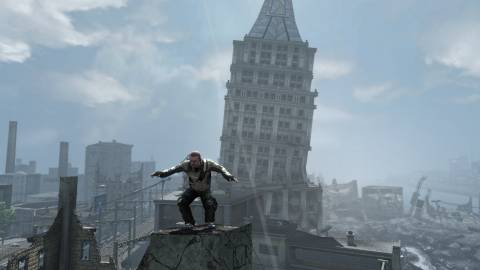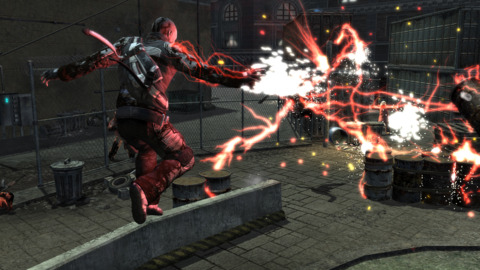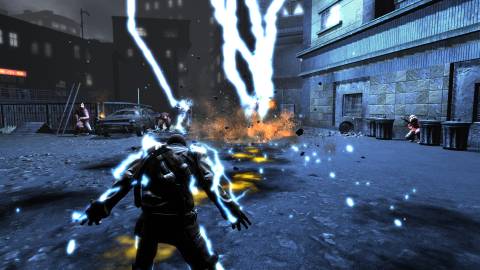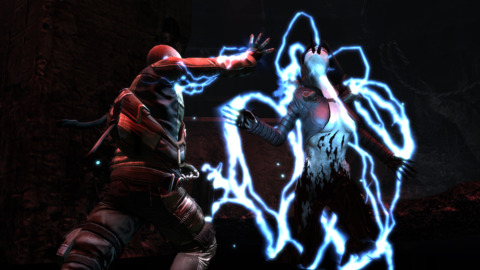
OK, now that those minor complaints are out of the way, I can spend the rest of the review talking about how much fun I had blasting, zapping, climbing, and flying around the big urban comic book world Sucker Punch created for this game.
InFamous really is a comic book transposed into the video game format. It even starts out with a quick, outlandish origin story: You're bike messenger Cole McGrath, delivering a routine package that turns out to be a mysterious, unusual bomb. After unwittingly leveling half of Empire City, you wake up in the smoldering crater with the sudden ability to control electricity and use it as a weapon. You'll need all the help you can get, because the city is placed under quarantine as a plague ravages the survivors and a bunch of gangs terrorize the populace. It's clear the government isn't coming to help anytime soon, so Cole has to step up and try to make a difference amidst all the madness.
In the wake of the bomb, there are a bunch of other comic book-style villains and supporting characters coloring up the ruins of Empire City. There's a frail, embittered old man with telekinetic powers; a freaky telepathic lady with some serious jealousy issues; your aforementioned chubby friend Zeke; your now ex-girlfriend who blames you for blowing up her sister along with half the city's residents; a mysterious Illuminati-esque organization which may or may not have engineered the blast; and, of course, the shadowy, hooded, mechanical-armed figure who's actually pulling all the strings.

Even if the story was trite or nonexistent, though, the quality of the action would be enough to carry InFamous. The speed and feel of the movement, aiming, firing, dodging, climbing, and jumping has a looseness and fluidity that makes the game extremely satisfying to play. Navigating the urban environment is also a pleasure; Cole automatically grabs for ledges and handholds, allowing him to make his way up building faces, lampposts, and just about any other city feature with ease, so you can get around as easily as you can dish out your attacks.
The brilliant controls work with the array of superpowers at your disposal--which mostly mimic established shooter archetypes like grenades, rocket launchers, and sniper rifles, and a few borrowed from Star Wars like a kinetic push and a ground slam--to make it incredibly satisfying to use all your destructive tools against the game's many enemies. There are almost endless ways to combine the many powers together dynamically in a big firefight; it's enough to keep the combat totally engaging till the end of the game, especially since you get access to new powers at regular intervals right up to the last few missions.

Anyway, in practical terms your alignment primarily determines which upgrades you have access to. The powers all have three upgrades, one for each karma level, and each subsequent upgrade adds some kind of damage boost, extra effect, or modifier, making it well worth maxing out as many of them as you can. The good versions of the powers focus on restraining enemies without killing them and minimizing civilian casualties, while the evil powers are all about big, wanton destruction. Your alignment also makes your electricity blue or red, but it doesn't have much bearing on the storyline--other than a couple of minor points, and the way the populace reacts to you--so if you don't have any moral hangups, you can tailor your choices to the sort of weapons you'd like to use. Both styles are fun to play, just in different ways.

Aside from the minor technical issues, there are a lot of good things to say about InFamous' presentation. The city is densely packed and nicely designed with a variety of different building styles (which is nice, since you see them up-close so frequently). In lieu of a repeating day-to-night cycle, I like that the story is broken up into specific days with preset weather and lighting conditions, so the visual backdrop can work to help set the tone of the story. The music is great and has a really gritty, urban feel to it with a lot of driving percussion; I just wish you got to hear more of it. It's a nicely produced package, overall.
But it's the quality of the central action in InFamous that I keep coming back to. Everything else would be fancy window dressing if Sucker Punch hadn't nailed the basic gameplay elements, the simple moving and shooting, as precisely as it did. InFamous feels like a game designed from the very ground up to be fun to play, so I guess it's no surprise that as soon as the credits finished rolling on my good version of Cole, I started up an evil one to play it all over again.